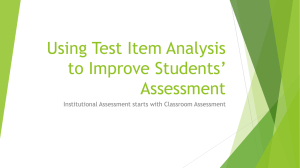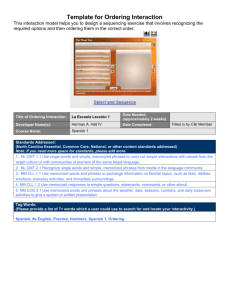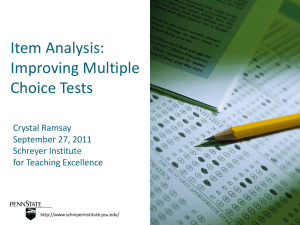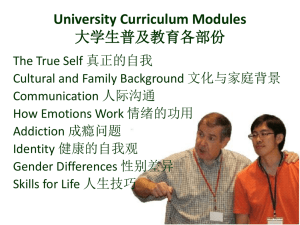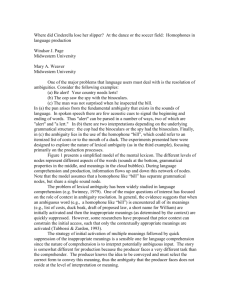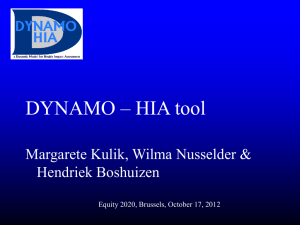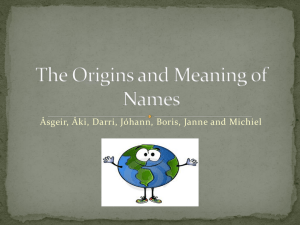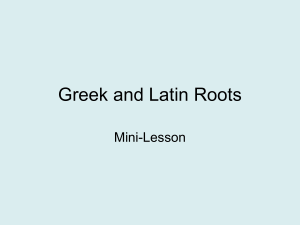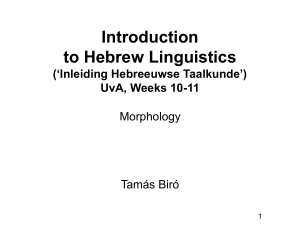Written morphological analogies in Hebrew
advertisement
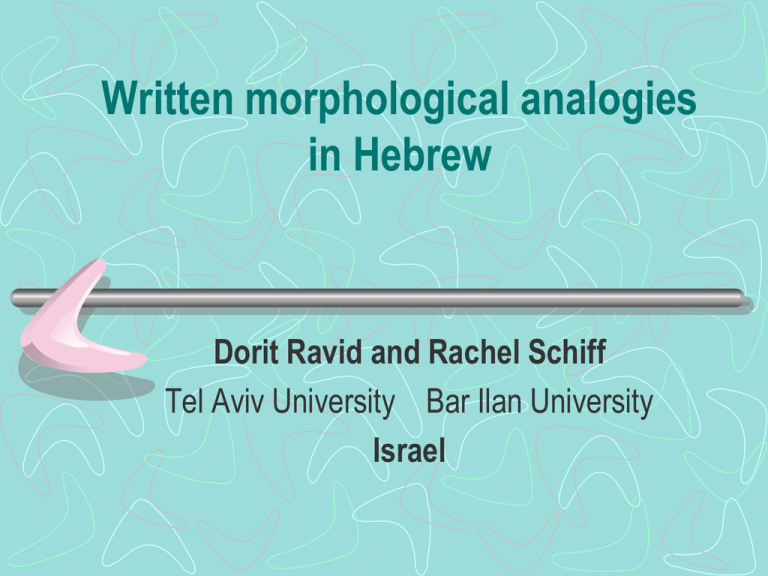
Written morphological analogies in Hebrew Dorit Ravid and Rachel Schiff Tel Aviv University Bar Ilan University Israel Morphology • One of the organizing principles of the mental lexicon • Morphemes and words Morphology • One of the organizing principles of the mental lexicon • Morphemes and words • Crucial importance in Hebrew – Highly synthetic Semitic language Hebrew morphology: Roots and patterns katav hixtiv katuv mixtav kituv wrote dictated written letter subtitle któvet ktav ktiv katvan katava address writing spelling typist journalistic report hitkatvut ktuba correspondence marriage contract taxtiv dictate Roots and patterns: k-t-b ‘write' כתב katav hixtiv katuv mixtav kituv wrote dictated written letter subtitle כתב הכתיב כתוב מכתב כיתוב któvet ktav ktiv katvan katava address writing spelling כתובת כתב hitkatvut כתיב typist כתבה כתבן ktuba correspondence marriage contract התכתבות כתובה journalistic report taxtiv dictate תכתיב Roots (k-t-b, g-d-l, p-r-s-m) Spoken roots • • • • Discontinuous 3-4 consonants Phonological alternations Lexical core of morphological family • Salient Written roots • • • • Almost continuous 3-4 letters Consistent orthography Construal as entity fostered by written properties Patterns (hiCCiC, CaCuC, miCCaC) • • • • Spoken patterns Discontinuous Prosodic templates Provide internal vowels (+ prefixes / suffixes) Categorial meaning – Verbal – Nominal • Less salient than roots • • • • Written patterns Scant orthographic representation Vowels: almost no representation Discrete prefix, suffix Construal as entity obscured by written properties Implications for reading and writing • The lexically meaningful part of the word is represented in its center; letters framing the word carry grammatical and categorial meaning • WKŠBMGDLYKM וכשבמגדליכם u-xshe-be-migdaley-xem ‘and-when-in-towersyoursPl’ • Root GDL ‘grow’ surrounded by function elements The current study • Investigates Hebrew readers’ ability to analyze roots and patterns in written Hebrew wordforms • Focus on nominal patterns • Testing the ability to extract and recombine roots and patterns from written Hebrew nominals using a morphological analogies task Participants 1. 152 gradeschool children, middle-high SES 2. 167 gradeschoo children, low SES – – Five age-groups each: 2nd, 3rd, 4th, 5th and 6th graders All monolingual speakers of Hebrew as a native tongue with no diagnosed language or learning disabilities 3. 38 undergraduate education students, all with a long history of reading difficulties and diagnosed with reading disabilities within three years prior to attending university or while attending university; All monolingual speakers of Hebrew as a native tongue The Morphological Analogies Task (MAT) • 40 analogy sets • Each set contains two components: – A set of stimulus nouns – A set of possible responses • The task requires the selection of a target noun from the set of responses to complete the stimulus set Analogy structure P a t t e r n r e l a t i o n s h i p Root relationship KPL כפל kéfel ‘multiplication’ MKPLH מכפלה maxpela ‘multiple,N’ SRŦ סרט séret ‘film’ Pattern source ? (MSRŦH )מסרטה (masreta ‘projector’) Root source Root relationship P a t t e r n r e l a t i o n s h i p Response set 1. 2. 3. 4. 5. Correct response: target noun MSRŦH ‘ מסרטהprojector’ Main root distracter: a word containing the same root as the root source, but not the same pattern TSRYŦ ‘ תסריטscript’ Pattern distracter: a word containing the same pattern as the pattern source, but not the same root MGRPH ‘ מגרפהrake’ Secondary root distracter: a word containing the same root shared by members of the top horizontal pair KPYL ‘ כפילdouble’ Semantic distracter: associated semantically or pragmatically but not morphologically to left-hand member of horizontal pair KWLNW9 ‘ קולנועmovies’ Correct responses: 100 High and Low SES gradeschoolers 90 H-SES % correct responses 80 70 60 50 40 L-SES 30 20 5/6 > 3/4 > 2 High > Low 10 0 G2 G3 G4 G5 G6 Correct responses: 100 High and Low SES gradeschoolers, adult dyslexic students 90 H-SES % correct responses 80 70 60 Ad dys 50 40 L-SES 30 20 10 0 G2 G3 G4 G5 G6 Adult dyslexics Correct responses: High and Low SES gradeschoolers, adult dyslexic students 100 90 H-SES % correct responses 80 70 60 Ad dys 50 L-SES 40 30 20 10 0 G2 G3 G4 G5 G6 Adult dyslexics Erroneous response types: High SES 100% 80% Semantic distracter 60% Secondary root distracter Pattern distracter 40% Main root distracter 20% 0% G2 G3 G4 G5 G6 Main root response Few pattern, semantic responses No age differences Erroneous response types: Low SES Main root: increase with age; Secondary root: decline with age Semantic and pattern distracters: decline with age 100% 90% 80% 70% 60% 50% 40% 30% 20% 10% 0% Semantic distracter Secondary root distracter Pattern distracter Main root distracter G2 G3 G4 G5 G6 Erroneous response types: Adult dyslexic students 100% 90% 80% 70% 60% 50% 40% 30% 20% 10% 0% Semantic distracter Secondary root distracter Pattern distracter Main root distracter Main root distracter Semantic distracter Summary and conclusions • Analytical morphological skills from early on in normally developing Hebrew speakers – More in high-SES gradeschoolers, less in low-SES • Dyslexics are ‘stuck’ with the analytic skills of 3rd and 4th graders – Revert to non-morphological strategies absent in typically-developing children Summary and conclusions • Roots perceived as the prime lexical construct in Hebrew words • Patterns less salient and their perception lags behind that of roots • But - impossible to solve the MAT without recourse to both root and pattern Correct responses: 100 High SES gradeschoolers, real versus nonce words 90 % correct responses 80 70 60 50 40 30 20 10 Nonce: 5/6 > 2/3/4 Real > nonce Real words Nonce words 0 G2 G3 G4 G5 G6 Erroneous response types: High-SES, nonce words 100% 90% 80% 70% 60% 50% 40% 30% 20% 10% 0% Secondary root distracter Pattern distracter Main root distracter G2 G3 G4 G5 G6 Main root: decline with age Pattern: surge in 5/6
